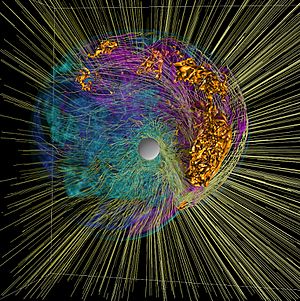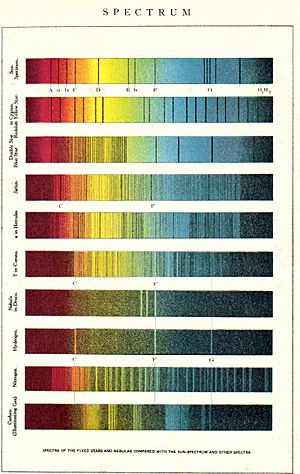Astrophysics

Astrophysics is a cool science that helps us understand how stars, planets, and the whole Universe work. Astrophysicists use the rules of physics to explain what astronomers see through telescopes.
It also looks at how the Universe began and how it's changing. This part of astrophysics is called cosmology.
How We Learned About Space
For a long time, people thought that things in space were totally different from things on Earth. They believed stars and planets were perfect, unchanging balls moving in circles, while on Earth, things changed and moved in straight lines.
But in the 1500s and 1600s, smart thinkers like Nicolaus Copernicus, Johannes Kepler, Galileo, and Newton started to think differently. They realized that the same natural laws that work on Earth also apply to space.
Newton's Big Idea
When scientists figured out how the planets moved, the science of astrophysics truly began. Sir Isaac Newton was a key figure. He understood that the same rules of mechanics (how things move) that he discovered on Earth could also predict how planets move in space.
He famously said, "As above, so below." This meant that by studying how things work here on our planet, we can learn how things work far away in space.
Later, scientists found another amazing way to learn about stars. By looking at the light coming from stars, they could figure out what the stars were made of. This special process is called spectroscopy.
Kinds of Astrophysics

There are two main ways astrophysicists study the Universe:
- Observational astrophysics
- This is a lot like astronomy. Observational astrophysicists use powerful telescopes to look at the Universe.
- But instead of just looking, they study the physics of what they see. They want to explain why things in space behave the way they do.
- Examples of what they use:
- Radio telescopes
- Optical telescopes (what we usually think of)
- Infrared telescopes
- Ultraviolet, X-ray, and gamma ray telescopes (often in space)
- Theoretical astrophysics
- This type of astrophysics uses information from observations, along with theories and mathematics, to explain how the Universe works.
- Cosmology (the study of the Universe's origin and future) is a big part of theoretical astrophysics.
- Some of the big questions they try to answer include:
- How did our Solar System form and change over time?
- How do stars form and live their lives?
- How do galaxies form and grow?
- What is the large-scale structure of matter in the Universe?
- Where do cosmic rays come from?
- How does General relativity (Einstein's theory of gravity) affect space?
- How does the universe evolve over billions of years?
Related pages
See also
 In Spanish: Astrofísica para niños
In Spanish: Astrofísica para niños


